lock HUMMER H2 2005 Owners Manual
[x] Cancel search | Manufacturer: HUMMER, Model Year: 2005, Model line: H2, Model: HUMMER H2 2005Pages: 468, PDF Size: 3.21 MB
Page 1 of 468
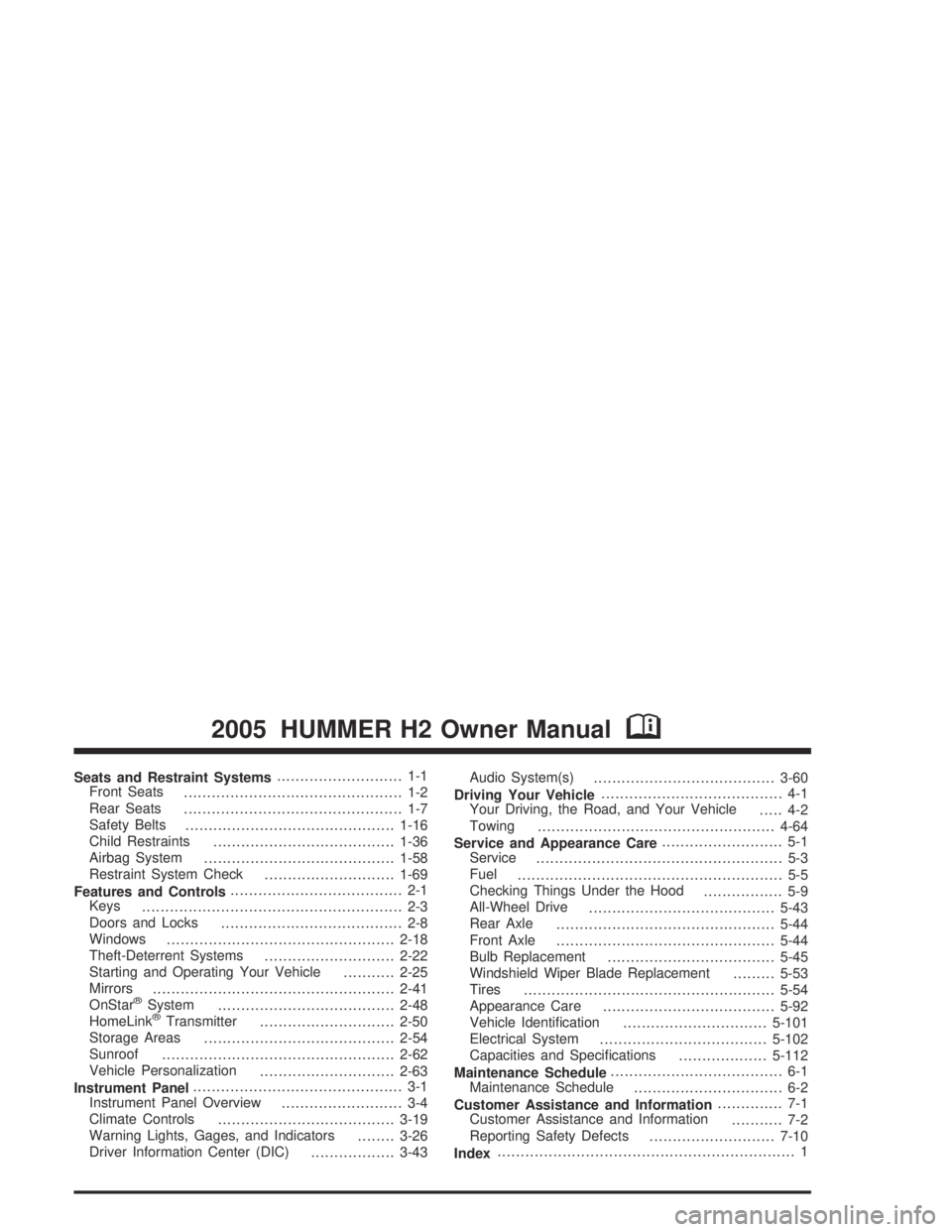
Seats and Restraint Systems........................... 1-1
Front Seats
............................................... 1-2
Rear Seats
............................................... 1-7
Safety Belts
.............................................1-16
Child Restraints
.......................................1-36
Airbag System
.........................................1-58
Restraint System Check
............................1-69
Features and Controls..................................... 2-1
Keys
........................................................ 2-3
Doors and Locks
....................................... 2-8
Windows
.................................................2-18
Theft-Deterrent Systems
............................2-22
Starting and Operating Your Vehicle
...........2-25
Mirrors
....................................................2-41
OnStar
®System
......................................2-48
HomeLink®Transmitter
.............................2-50
Storage Areas
.........................................2-54
Sunroof
..................................................2-62
Vehicle Personalization
.............................2-63
Instrument Panel............................................. 3-1
Instrument Panel Overview
.......................... 3-4
Climate Controls
......................................3-19
Warning Lights, Gages, and Indicators
........3-26
Driver Information Center (DIC)
..................3-43Audio System(s)
.......................................3-60
Driving Your Vehicle....................................... 4-1
Your Driving, the Road, and Your Vehicle
..... 4-2
Towing
...................................................4-64
Service and Appearance Care.......................... 5-1
Service
..................................................... 5-3
Fuel
......................................................... 5-5
Checking Things Under the Hood
................. 5-9
All-Wheel Drive
........................................5-43
Rear Axle
...............................................5-44
Front Axle
...............................................5-44
Bulb Replacement
....................................5-45
Windshield Wiper Blade Replacement
.........5-53
Tires
......................................................5-54
Appearance Care
.....................................5-92
Vehicle Identi�cation
...............................5-101
Electrical System
....................................5-102
Capacities and Speci�cations
...................5-112
Maintenance Schedule..................................... 6-1
Maintenance Schedule
................................ 6-2
Customer Assistance and Information.............. 7-1
Customer Assistance and Information
........... 7-2
Reporting Safety Defects
...........................7-10
Index................................................................ 1
2005 HUMMER H2 Owner ManualM
Page 14 of 468
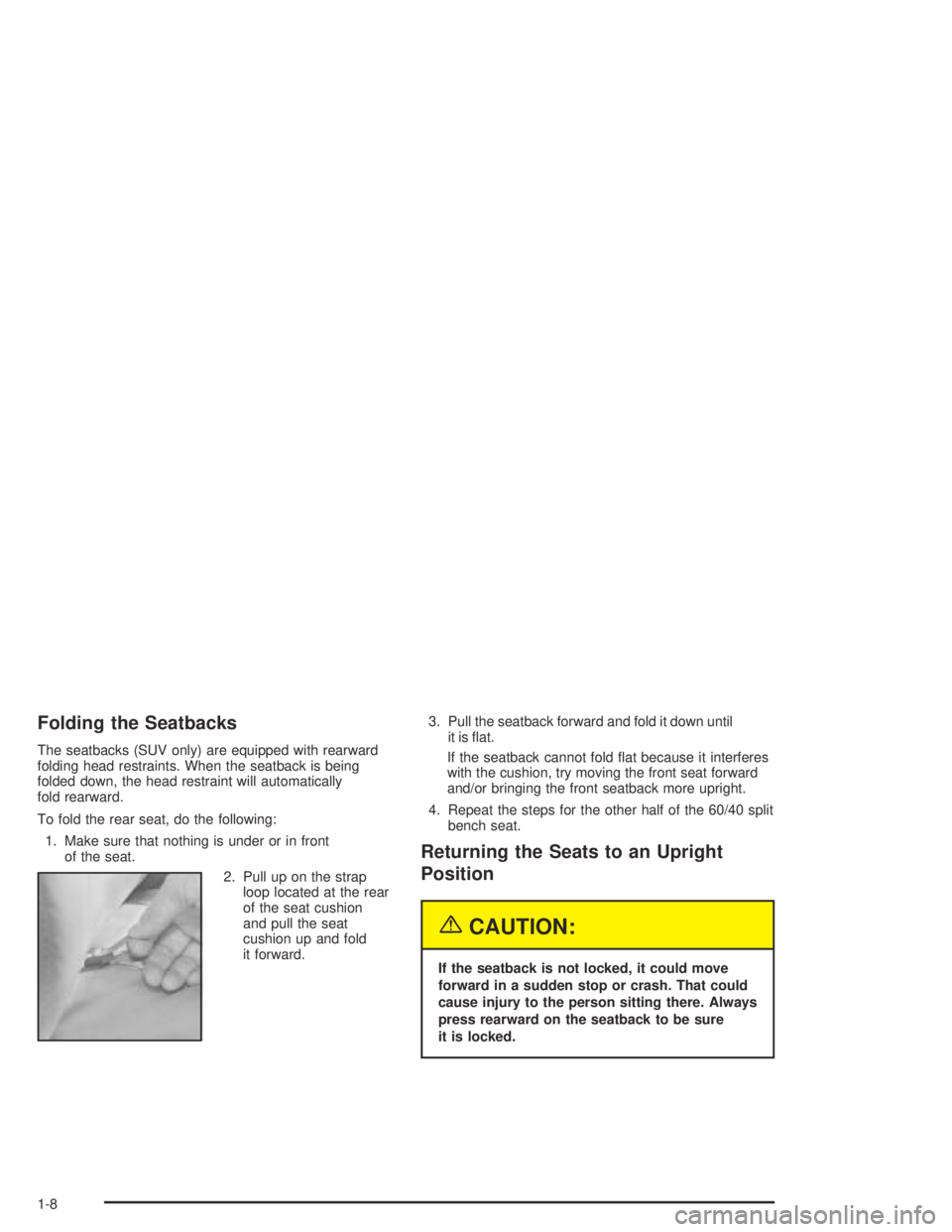
Folding the Seatbacks
The seatbacks (SUV only) are equipped with rearward
folding head restraints. When the seatback is being
folded down, the head restraint will automatically
fold rearward.
To fold the rear seat, do the following:
1. Make sure that nothing is under or in front
of the seat.
2. Pull up on the strap
loop located at the rear
of the seat cushion
and pull the seat
cushion up and fold
it forward.3. Pull the seatback forward and fold it down until
it is �at.
If the seatback cannot fold �at because it interferes
with the cushion, try moving the front seat forward
and/or bringing the front seatback more upright.
4. Repeat the steps for the other half of the 60/40 split
bench seat.
Returning the Seats to an Upright
Position
{CAUTION:
If the seatback is not locked, it could move
forward in a sudden stop or crash. That could
cause injury to the person sitting there. Always
press rearward on the seatback to be sure
it is locked.
1-8
Page 16 of 468
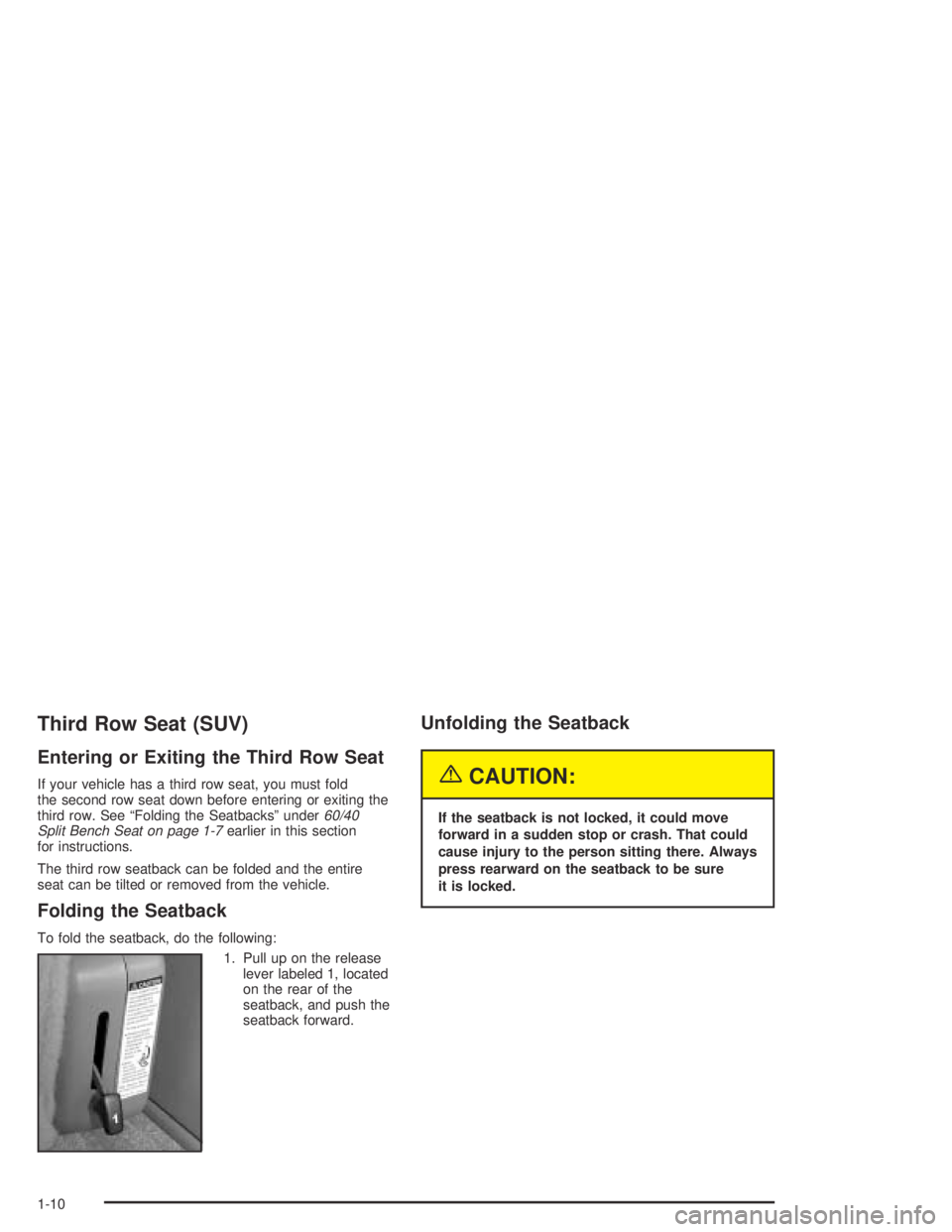
Third Row Seat (SUV)
Entering or Exiting the Third Row Seat
If your vehicle has a third row seat, you must fold
the second row seat down before entering or exiting the
third row. See “Folding the Seatbacks” under60/40
Split Bench Seat on page 1-7earlier in this section
for instructions.
The third row seatback can be folded and the entire
seat can be tilted or removed from the vehicle.
Folding the Seatback
To fold the seatback, do the following:
1. Pull up on the release
lever labeled 1, located
on the rear of the
seatback, and push the
seatback forward.
Unfolding the Seatback
{CAUTION:
If the seatback is not locked, it could move
forward in a sudden stop or crash. That could
cause injury to the person sitting there. Always
press rearward on the seatback to be sure
it is locked.
1-10
Page 17 of 468
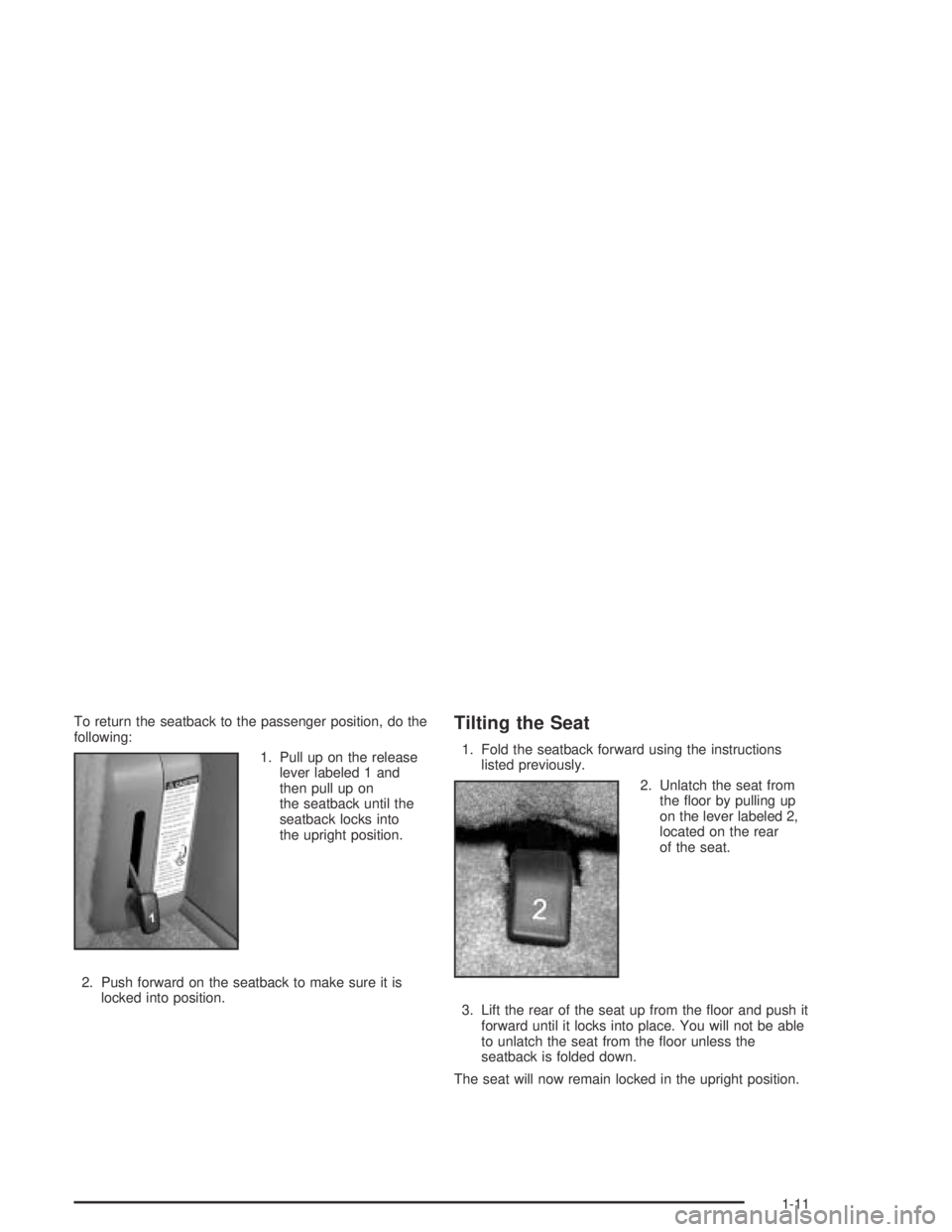
To return the seatback to the passenger position, do the
following:
1. Pull up on the release
lever labeled 1 and
then pull up on
the seatback until the
seatback locks into
the upright position.
2. Push forward on the seatback to make sure it is
locked into position.Tilting the Seat
1. Fold the seatback forward using the instructions
listed previously.
2. Unlatch the seat from
the �oor by pulling up
on the lever labeled 2,
located on the rear
of the seat.
3. Lift the rear of the seat up from the �oor and push it
forward until it locks into place. You will not be able
to unlatch the seat from the �oor unless the
seatback is folded down.
The seat will now remain locked in the upright position.
1-11
Page 18 of 468
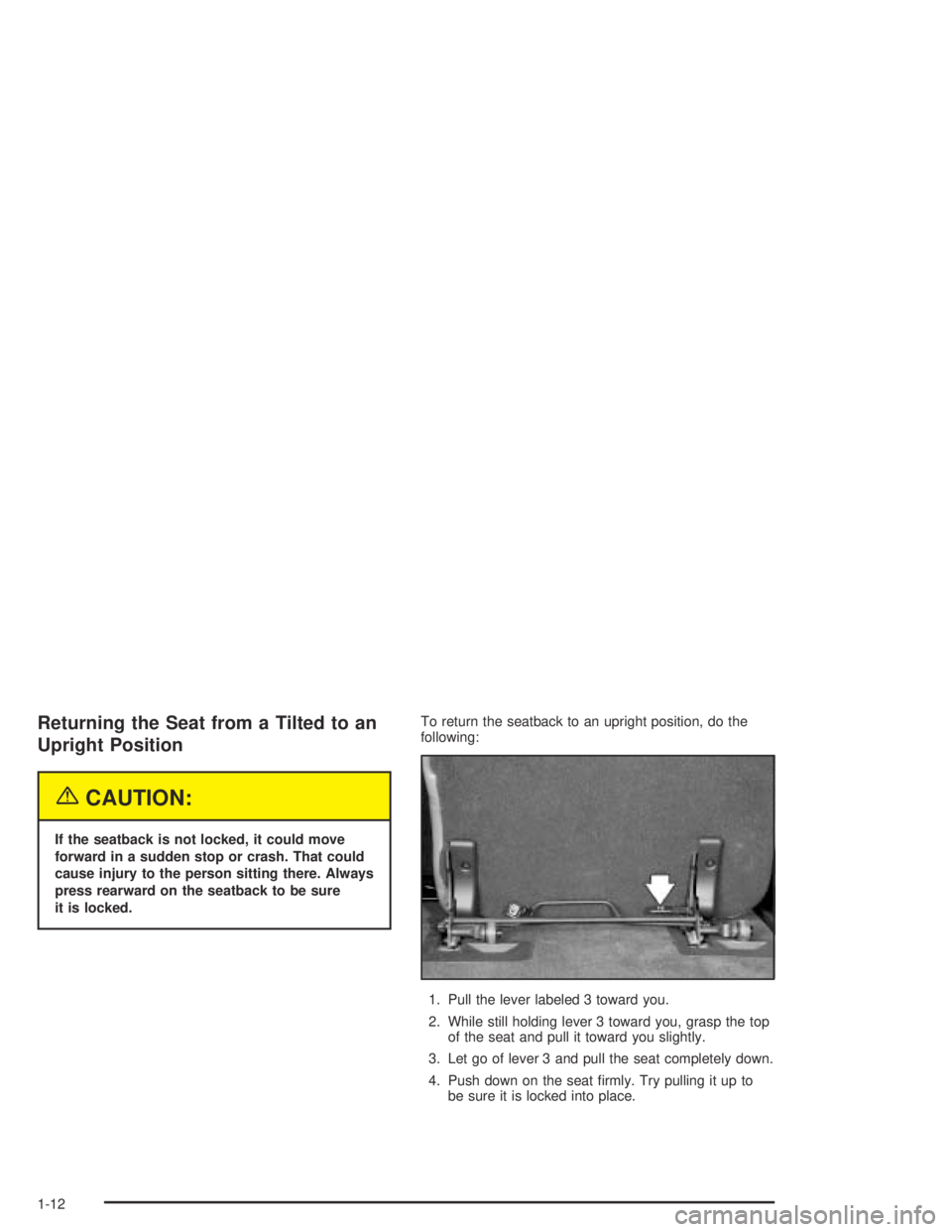
Returning the Seat from a Tilted to an
Upright Position
{CAUTION:
If the seatback is not locked, it could move
forward in a sudden stop or crash. That could
cause injury to the person sitting there. Always
press rearward on the seatback to be sure
it is locked.To return the seatback to an upright position, do the
following:
1. Pull the lever labeled 3 toward you.
2. While still holding lever 3 toward you, grasp the top
of the seat and pull it toward you slightly.
3. Let go of lever 3 and pull the seat completely down.
4. Push down on the seat �rmly. Try pulling it up to
be sure it is locked into place.
1-12
Page 19 of 468
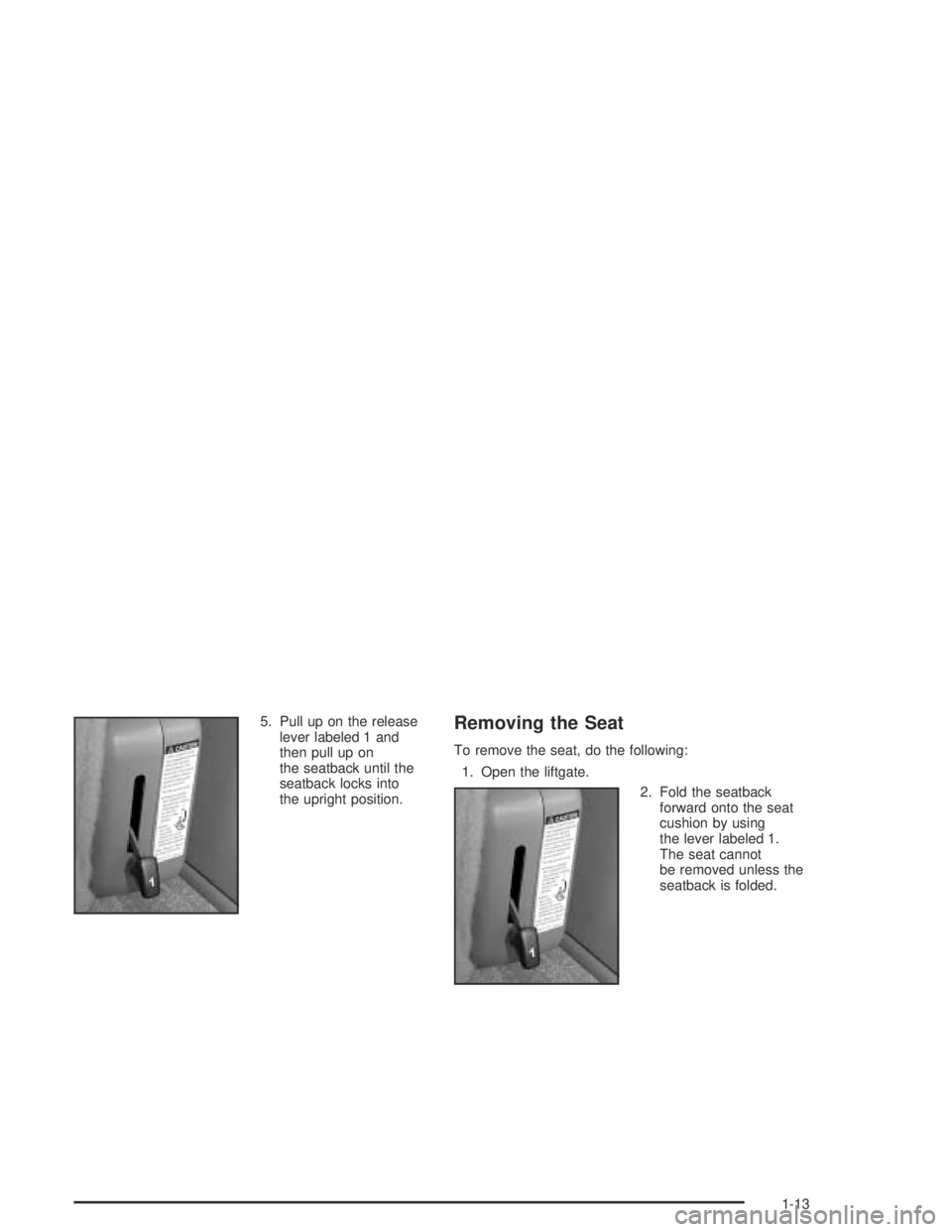
5. Pull up on the release
lever labeled 1 and
then pull up on
the seatback until the
seatback locks into
the upright position.Removing the Seat
To remove the seat, do the following:
1. Open the liftgate.
2. Fold the seatback
forward onto the seat
cushion by using
the lever labeled 1.
The seat cannot
be removed unless the
seatback is folded.
1-13
Page 21 of 468
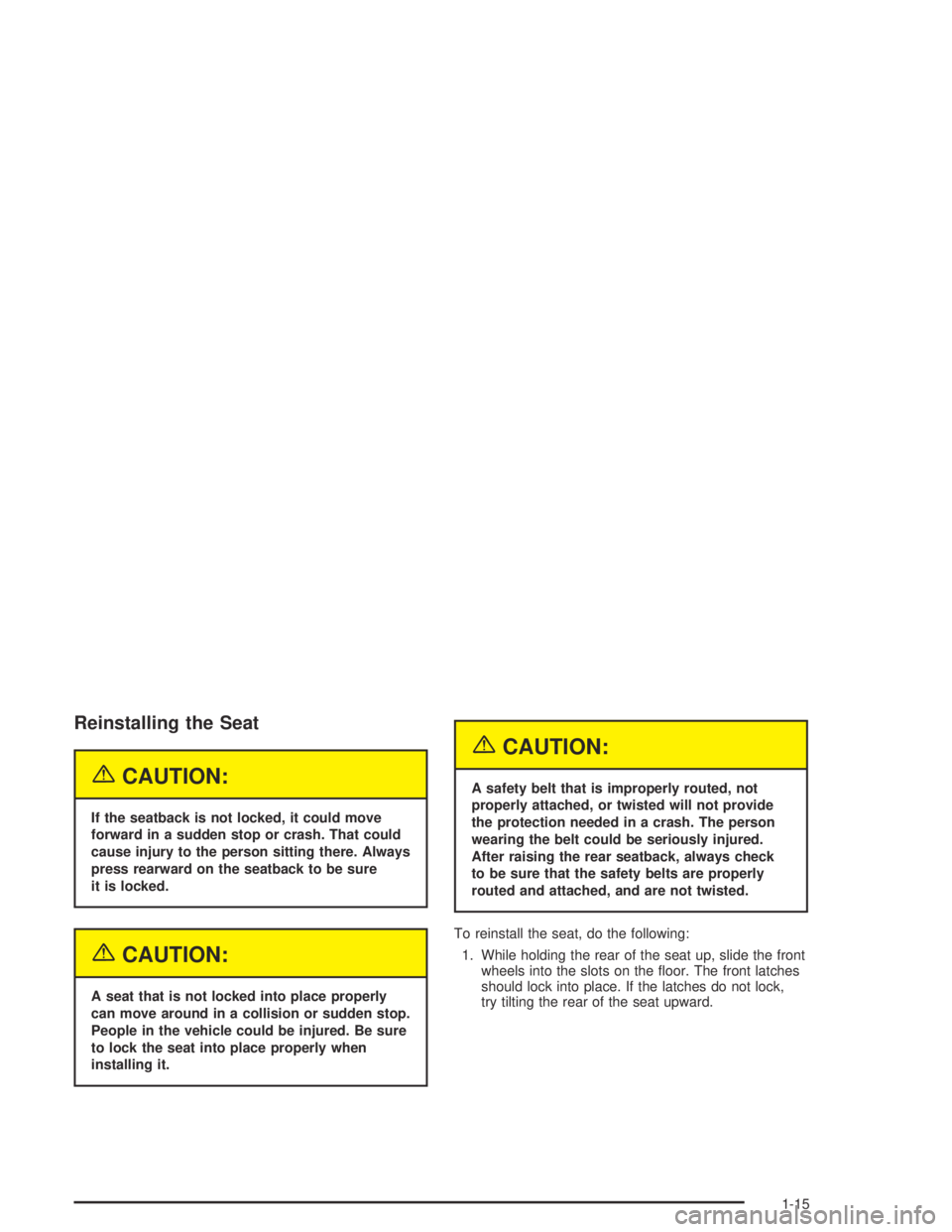
Reinstalling the Seat
{CAUTION:
If the seatback is not locked, it could move
forward in a sudden stop or crash. That could
cause injury to the person sitting there. Always
press rearward on the seatback to be sure
it is locked.
{CAUTION:
A seat that is not locked into place properly
can move around in a collision or sudden stop.
People in the vehicle could be injured. Be sure
to lock the seat into place properly when
installing it.
{CAUTION:
A safety belt that is improperly routed, not
properly attached, or twisted will not provide
the protection needed in a crash. The person
wearing the belt could be seriously injured.
After raising the rear seatback, always check
to be sure that the safety belts are properly
routed and attached, and are not twisted.
To reinstall the seat, do the following:
1. While holding the rear of the seat up, slide the front
wheels into the slots on the �oor. The front latches
should lock into place. If the latches do not lock,
try tilting the rear of the seat upward.
1-15
Page 22 of 468
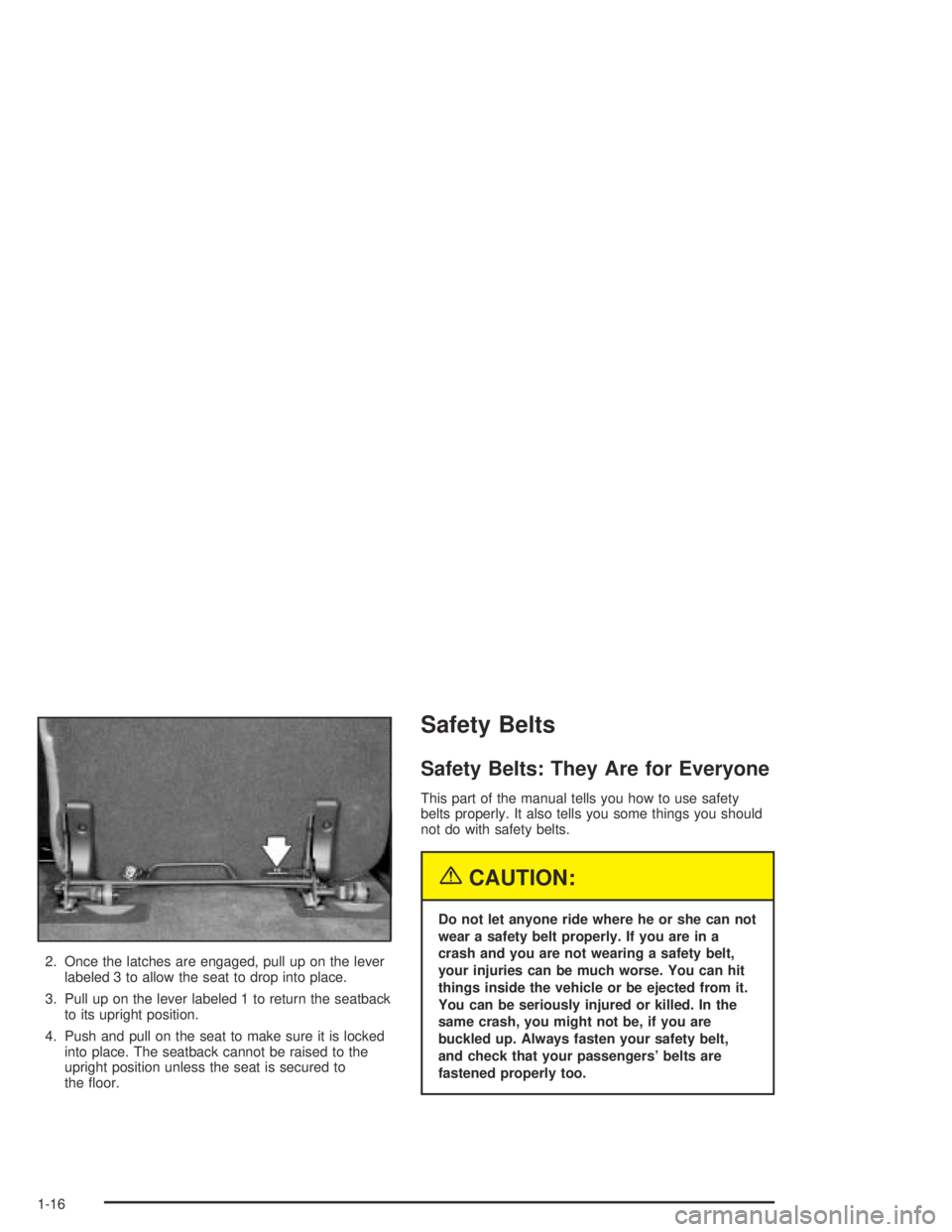
2. Once the latches are engaged, pull up on the lever
labeled 3 to allow the seat to drop into place.
3. Pull up on the lever labeled 1 to return the seatback
to its upright position.
4. Push and pull on the seat to make sure it is locked
into place. The seatback cannot be raised to the
upright position unless the seat is secured to
the �oor.
Safety Belts
Safety Belts: They Are for Everyone
This part of the manual tells you how to use safety
belts properly. It also tells you some things you should
not do with safety belts.
{CAUTION:
Do not let anyone ride where he or she can not
wear a safety belt properly. If you are in a
crash and you are not wearing a safety belt,
your injuries can be much worse. You can hit
things inside the vehicle or be ejected from it.
You can be seriously injured or killed. In the
same crash, you might not be, if you are
buckled up. Always fasten your safety belt,
and check that your passengers’ belts are
fastened properly too.
1-16
Page 28 of 468
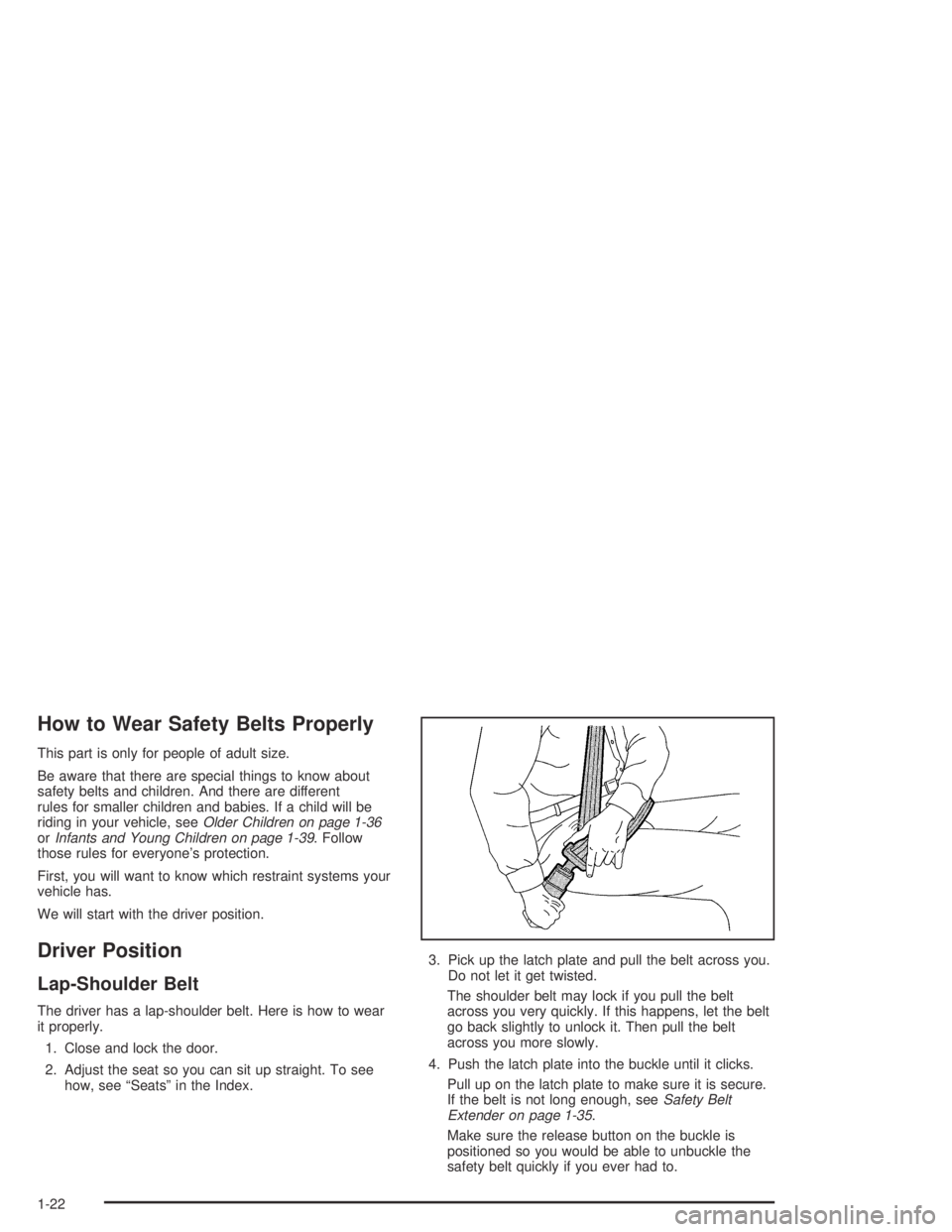
How to Wear Safety Belts Properly
This part is only for people of adult size.
Be aware that there are special things to know about
safety belts and children. And there are different
rules for smaller children and babies. If a child will be
riding in your vehicle, seeOlder Children on page 1-36
orInfants and Young Children on page 1-39. Follow
those rules for everyone’s protection.
First, you will want to know which restraint systems your
vehicle has.
We will start with the driver position.
Driver Position
Lap-Shoulder Belt
The driver has a lap-shoulder belt. Here is how to wear
it properly.
1. Close and lock the door.
2. Adjust the seat so you can sit up straight. To see
how, see “Seats” in the Index.3. Pick up the latch plate and pull the belt across you.
Do not let it get twisted.
The shoulder belt may lock if you pull the belt
across you very quickly. If this happens, let the belt
go back slightly to unlock it. Then pull the belt
across you more slowly.
4. Push the latch plate into the buckle until it clicks.
Pull up on the latch plate to make sure it is secure.
If the belt is not long enough, seeSafety Belt
Extender on page 1-35.
Make sure the release button on the buckle is
positioned so you would be able to unbuckle the
safety belt quickly if you ever had to.
1-22
Page 29 of 468
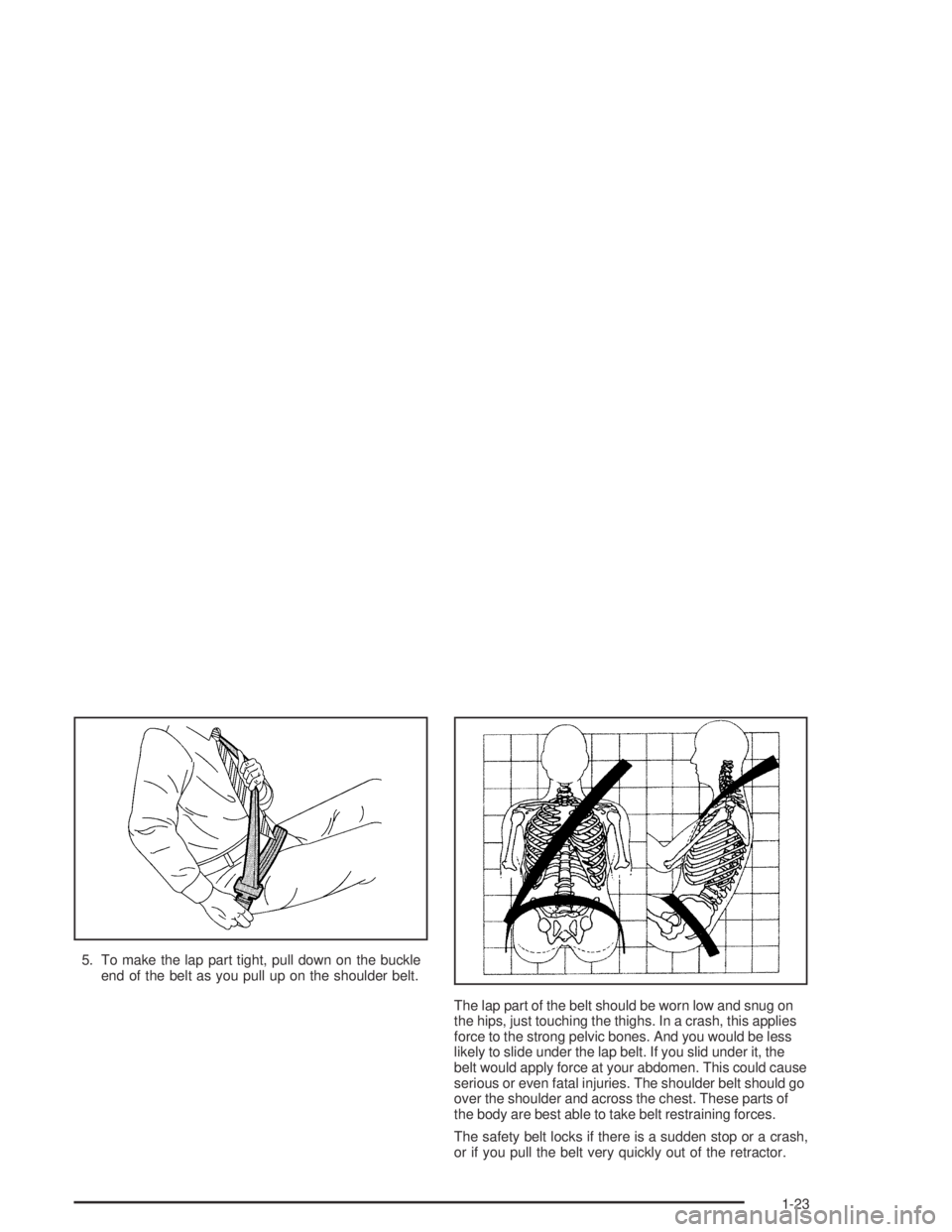
5. To make the lap part tight, pull down on the buckle
end of the belt as you pull up on the shoulder belt.
The lap part of the belt should be worn low and snug on
the hips, just touching the thighs. In a crash, this applies
force to the strong pelvic bones. And you would be less
likely to slide under the lap belt. If you slid under it, the
belt would apply force at your abdomen. This could cause
serious or even fatal injuries. The shoulder belt should go
over the shoulder and across the chest. These parts of
the body are best able to take belt restraining forces.
The safety belt locks if there is a sudden stop or a crash,
or if you pull the belt very quickly out of the retractor.
1-23